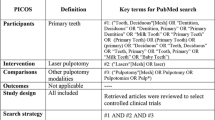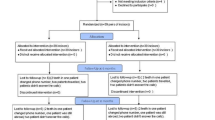Abstract
A pulpotomy is the therapy for management of pulp exposures due to caries in symptom-free primary molars. The aim was to longitudinally compare the relative effectiveness of the Er:YAG laser, calcium hydroxide and ferric sulphate techniques with dilute formocresol in retaining symptom-free molars. Two hundred primary molars in 107 healthy children were included and randomly allocated to one technique. The treated teeth were blindly reevaluated after 6, 12, 18, 24 and 36 months. Descriptive data analysis and logistic regression analysis accounting for multiple observations per patient by generalised estimating equation were used. Additionally, various influences including tooth type, upper and lower jaws, type of anaesthesia, operator and the final restoration on treatment success were evaluated (Wald chi-square test). After 36 months, the following total (considering clinical and clinically symptom-free radiographic failures) and clinical success rates were determined (in percent): Formocresol 72 (92), laser 73 (89), calcium hydroxide 46 (75), ferric sulphate 76 (97). No significant differences were detected between formocresol and any other technique after 36 months. However, the odds ratio of failure appeared to be three times higher for calcium hydroxide than for formocresol. No significant differences in total success rates were seen regarding the aforementioned influencing clinical parameters. The correct diagnosis of the pulpal status, bleeding control and the specific technique are highly important for long-term success of pulpotomies in primary molars. According to the presented long-term data, pulpotomies using ferric sulphate revealed the best treatment outcome among the used techniques, while calcium hydroxide resulted in the lowest success rates after 3 years. Therefore, we can recommend ferric sulphate for easy and successful treatment of primary molars with caries-exposed pulps.

Similar content being viewed by others
References
Fuks AB (2008) Vital pulp therapy with new materials for primary teeth: new directions and treatment perspectives. Pediatr Dent 30:211–219
AAPD Clinical Affairs Committee of the American Academy Pediatric Dentistry - Pulp Therapy Subcommittee: Guideline on pulp therapy for primary and immature permanent teeth. Reference Manual 2010–2011;V32/No 6:194–201
Fuks AB, Papagiannoulis L (2006) Pulpotomy in primary teeth: review of the literature according to standardized criteria. Eur Arch Paediatr Dent 7:64–71, discussion 72
Nadin G, Goel BR, Yeung CA, Glenny AM (2008) Pulp treatment for extensive decay in primary teeth. In: The Cochrane Library Issue 4
Zarzar PA, Rosenblatt A, Takahashi CS, Takeuchi PL, Costa Junior LA (2003) Formocresol mutagenicity following primary tooth pulp therapy: an in vivo study. J Dent 31:479–485
Patchett CL, Srinivasan V, Waterhouse PJ (2006) Is there life after Buckley's formocresol? Part II—development of a protocol for the management of extensive caries in the primary molar. Int J Paediatr Dent 16:199–206
IARC International Agency for Research on Cancer (2006) Formaldehyde, 2-butoxyethanol and 1-tert-butoxypropan-2-ol. IARC Monographs on the Evaluation of Carcinogenic Risks to Humans 88
Matsumoto K (2000) Lasers in endodontics. Dent Clin North Am 44:889–906
Schoop U, Moritz A, Kluger W, Patruta S, Goharkhay K, Sperr W, Wernisch J, Gattringer R, Mrass P, Georgopoulos A (2002) The Er:YAG laser in endodontics: results of an in vitro study. Lasers Surg Med 30:360–364
Kimura Y, Yonaga K, Yokoyama K, Watanabe H, Wang X, Matsumoto K (2003) Histopathological changes in dental pulp irradiated by Er:YAG laser: a preliminary report on laser pulpotomy. J Clin Laser Med Surg 21:345–350
Jayawardena JA, Kato J, Moriya K, Takagi Y (2001) Pulpal response to exposure with Er:YAG laser. Oral Surg Oral Med Oral Pathol Radiol Endod 91:222–229
Liu JF (2006) Effects of Nd:YAG laser pulpotomy on human primary molars. J Endod 32:404–407
Odabas ME, Bodur H, Baris E, Demir C (2007) Clinical, radiographic, and histopathologic evaluation of Nd:YAG laser pulpotomy on human primary teeth. J Endod 33:415–421
Sonmez D, Duruturk L (2008) Ca(OH)2 pulpotomy in primary teeth. Part I: internal resorption as a complication following pulpotomy. Oral Surg Oral Med Oral Pathol Oral Radiol Endod 106:94–98
Moher D, Schulz KF, Altman DG (2001) The CONSORT Statement: revised recommendations for improving the quality of reports of parallel-group randomized trials. Ann Int Med 134:657–662
Thompson KS, Seale NS, Nunn ME, Huff G (2001) Alternative method of haemorrhage control in full strength formocresol pulpotomy. Pediatr Dent 23:217–222
Mielke CH, Kaneshiro MM, Maher IA, Weiner JM, Rapaport SI (1969) The standardized normal Ivy bleeding time and its prolongation by aspirin. Blood 34:204–215
Keller U, Hibst R (1991) Tooth pulp reaction following Er:YAG laser application. Proceedings of Lasers in Orthopedic, Dental, and Veterinary Medicine, Jan 23–24, Los Angeles, California. O'Brien SJ, Dederich DN, Wigdor H, Trent A, editors. Proc SPIE 1424:127–133
Altman DG (1991) Practical statistics for medical research. Chapman & Hall, London
Dupont WD, Plummer WD (1990) Power and sample size calculations: a review and computer program. Control Clin Trials 11:116–128
Benz C, Reeka A, Stroinj A, Hickel R (1998) Comparison of two pulpotomy techniques in deciduous dentition: a clinical study. Ital J Paediatr Dent 1:38–39
Fei AL, Udin R, Johnson R (1991) A clinical study of ferric sulfate as a pulpotomy agent in primary teeth. Pediatr Dent 13:327–331
Liang K-Y, Zeger S (1986) Longitudinal data analysis using generalized linear models. Biometrika 73:13–22
Huth KC, Paschos E, Hajek-Al-Khatar N, Hollweck R, Crispin A, Hickel R, Folwaczny M (2005) Effectiveness of 4 pulpotomy techniques—randomized controlled trial. J Dent Res 84:1144–1148
Moretti AB, Sakai VT, Oliveira TM, Fornetti AP, Santos CF, Machado MA, Abdo RC (2008) The effectiveness of mineral trioxide aggregate, calcium hydroxide and formocresol for pulpotomies in primary teeth. Int Endod J 41:547–555
Zurn D, Seale NS (2008) Light-cured calcium hydroxide vs formocresol in human primary molar pulpotomies: a randomized controlled trial. Pediatr Dent 30:34–41
Sonmez D, Sari S, Cetinbas T (2008) A comparison of four pulpotomy techniques in primary molars: a long-term follow-up. J Endod 34:950–955
Alacam A, Odabas ME, Tuzuner T, Sillelioglu H, Baygin O (2009) Clinical and radiographic outcomes of calcium hydroxide and formocresol pulpotomies performed by dental students. Oral Surg Oral Med Oral Pathol Oral Radiol Endod 108:127–133
Waterhouse PJ, Nunn JH, Whitworth JM (2000) An investigation of the relative efficacy of Buckley's formocresol and calcium hydroxide in primary molar vital pulp therapy. Br Dent J 188:32–36
Peng L, Ye L, Guo X, Tan H, Zhou X, Wang C, Li R (2007) Evaluation of formocresol versus ferric sulphate primary molar pulpotomy: a systematic review and meta-analysis. Int Endod J 40:751–757
Casas MJ, Layug MA, Kenny DJ, Johnston DH, Judd PL (2003) Two-year outcomes of primary molar ferric sulphate pulpotomy and root canal therapy. Pediatr Dent 25:97–102
Sonmez D, Duruturk L (2010) Success rate of calcium hydroxide pulpotomy in primary molars restored with amalgam and stainless steel crowns. Br Dent J 208:E18, discussion 408–409
Guelmann M, McIlwain MF, Primosch RE (2005) Radiographic assessment of primary molar pulpotomies restored with resin-based materials. Pediatr Dent 27:24–27
Lemon RR, Steele PJ, Jeansonne BG (1993) Ferric sulphate hemostasis: effect on osseous wound healing. Left in situ for maximum exposure. J Endod 19:170–173
Acknowledgements
The authors would like to express their gratitude towards Željka Maruniza, Kathrin Braunmüller, Kerstin Weidlich and Prof. Dr. Dr. Matthias Folwaczny for their participation in this clinical study and valuable discussion. The study was completely financed by departmental funding.
Conflict of interest
The authors declare that they have no conflict of interest.
Author information
Authors and Affiliations
Corresponding author
Electronic supplementary material
Below is the link to the electronic supplementary material.
ESM 1
(DOC 75 kb)
Rights and permissions
About this article
Cite this article
Huth, K.C., Hajek-Al-Khatar, N., Wolf, P. et al. Long-term effectiveness of four pulpotomy techniques: 3-year randomised controlled trial. Clin Oral Invest 16, 1243–1250 (2012). https://doi.org/10.1007/s00784-011-0602-3
Received:
Accepted:
Published:
Issue Date:
DOI: https://doi.org/10.1007/s00784-011-0602-3




